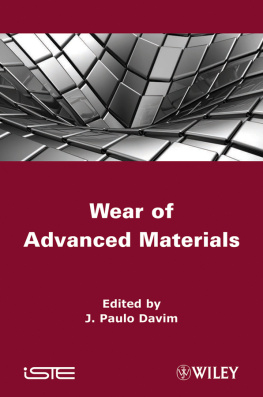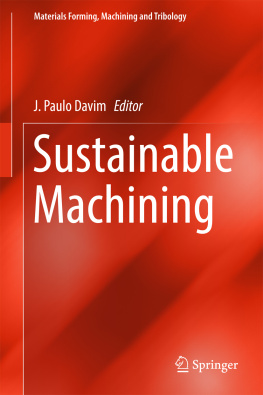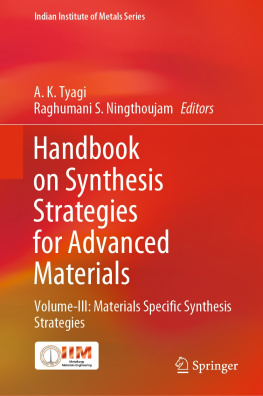First published 2012 in Great Britain and the United States by ISTE Ltd and John Wiley & Sons, Inc.
Apart from any fair dealing for the purposes of research or private study, or criticism or review, as permitted under the Copyright, Designs and Patents Act 1988, this publication may only be reproduced, stored or transmitted, in any form or by any means, with the prior permission in writing of the publishers, or in the case of reprographic reproduction in accordance with the terms and licenses issued by the CLA. Enquiries concerning reproduction outside these terms should be sent to the publishers at the undermentioned address:
ISTE Ltd
27-37 St Georges Road
London SW19 4EU
UK
www.iste.co.uk | John Wiley & Sons, Inc.
111 River Street
Hoboken, NJ 07030
USA
www.wiley.com |
ISTE Ltd 2012
The rights of J. Paulo Davim to be identified as the author of this work have been asserted by him in accordance with the Copyright, Designs and Patents Act 1988.
Library of Congress Cataloging-in-Publication Data
Wear of advanced materials / edited by J. Paulo Davim.
p. cm.
Includes bibliographical references and index.
ISBN 978-1-84821-352-4
1. Mechanical wear. 2. Strength of materials. I. Davim, J. Paulo.
TA418.4.W4174 2012
620.1'1292--dc23
2011044639
British Library Cataloguing-in-Publication Data
A CIP record for this book is available from the British Library
ISBN: 978-1-84821-352-4
Table of Contents
In general, we currently define wear as the progressive loss of material from the operating surface of a body occurring as a result of relative motion at the surface. Wear is related to surface interactions, and more specifically to the form of contact due to relative motion. It is important to distinguish between mechanical wear and other processes with similar outcomes. For example, the current definition does not include:
impact wear, where there is no relative motion;
cavitation, where the counterbody is a fluid;
corrosion, where the damage is due to chemical rather than mechanical action.
The progressive loss of material from surface is rarely catastrophic but it does reduce the operating efficiency of equipment, components and structures.
The purpose of this book is to present a collection of examples illustrating the state-of-the-art and research developments into the wear of advanced materials in several applications.
presents tribological aspects of carbon fabricreinforced polymer composites.
covers the adhesive wear characteristics of the natural fibers of reinforced composites.
contains information on resistance to cavitation (material selection).
is dedicated to the cavitation of biofuel applied in the injection nozzles of diesel engines.
Finally, in , the wear and corrosion damage of medical-grade metals and alloys is presented.
The present book can be used as a research book for a final undergraduate engineering course (for example into materials, mechanics, etc.) or as the focus of the effect of wear on advanced materials at the postgraduate level. This book can serve also as a useful reference for academics, biomaterials researchers, mechanical and materials engineers, professionals in related spheres working with tribology and advanced materials. The interest in and the use of the topics covered in this book is evident for many important centers of research, laboratories and universities throughout the world. Therefore, it is hoped that this book will encourage and enthuse others to carry out research in this important field of science and engineering.
I would like to pass on my gratitude to ISTE-Wiley for this opportunity to expand the knowledge of others through the use of this book and I thank them for their professional support. Finally, I would like to thank all of the authors who worked on the various chapters for their work on this project.
J. Paulo Davim
University of Aveiro, Portugal
January 2012
The inclusion of carbon fiber reinforcement in composites in order to achieve high performance is currently one of the most attractive solutions when encountering increasing demands on the development of materials as a consequence of innovations in technology. Bidirectional reinforcement, as in the case of fabric, is preferable to the use of unidirectional or short fibers because of the possibility of higher specific strength in both directions and the ease of handling reinforcement during processing.
The performance of such composites is a result of various parameters, mainly related to their development and situations in which they are used under selected operating parameters. In the case of tribology, carbon fiber has special importance as reinforcement. This is especially the case in polymers because of their additional important features, such as lubricity and high thermal conductivity and stability.
The main parameters responsible for the performance of such composites during development are:
type of matrix and its molecular weight;
type of carbon fibers (polyacrylonitrile [PAN], pitch etc., or strands, tows, etc.);
amount of fabric and its weave;
orientation of fiber/fabric with respect to loading direction;
fibermatrix interface;
processing technique;
various parameters.
In spite of lot of work reported on carbon fabric-reinforced polymer composites, no in-depth information presenting an overview of such composites is currently available.
This chapter provides a comprehensive review of the parameters of such composites and their influence on performance properties (mechanical and tribological in various wear modes) is presented by our development of a number of composites by varying one parameter at a time. It is concluded that the above-mentioned parameters significantly control the performance of composites. The influence of parameters on tribological properties does, however, depend on the modes of wear that are selected. In this chapter, we show that reinforcement proves significantly beneficial for adhesive and fretting wear situations; whereas in abrasive and erosive situations it proves detrimental.
From the tribological point of view, polymers have key features such as self-lubricity, resistance to wear (in dry conditions), corrosion, impact and shocks. Apart from ease in processing of components, they offer quiet operation because of very good damping capabilities. Polymeric tribocomposites also have serious limitations, such as low thermal stability, low strength and deterioration at elevated temperatures. Hence, they are almost invariably used in a composite form.
These composites are used in a variety of triboapplications, such as ball bearings, cages, bushes, marine equipment, etc., and in load-bearing applications, such as struts, chassis and brackets in automotive and aircraft structures. This is because of their high flexural modulus, compressive strength and high resistance to corrosion [DOS 87]. In the aerospace industry, potential uses of composites containing graphite and carbon fibers include:
their use as liners for self-aligning plain spherical bearings, cages and braces for ball and roller bearings;
their use as a seal material for sliding-contact seals, piston rings, valves, bearings in copiers, business machines, space vehicle components, etc. [FUS 88].
Composites contain various constituents, such as fibers, fillers and solid lubricants of various types and sizes. Fibers generally increase load-carrying capacity and strength, and reduce the extent of the interaction of a polymer with the counterface, and hence reduce wear. Fibers are far more resistant to wear than the matrix, and the wear of fiberreinforced polymers (FRPs) is mainly controlled by fibers. The role of the matrix is to hold the fibers firmly in adverse conditions involving thermal and mechanical stresses. The performance of FRPs depends mainly on the type of fiber/s and matrix, concentration, distribution, aspect ratio, alignment with respect to loading direction, its adhesion to the matrix, processing technology, etc. Fibers with a high aspect ratio (l/r, where l and r are the length and radius of a fiber), have less chance of a concentration of flaws on their surface during loading, which effectively improves the rate of load transferred from the matrix to the fiber and hence the wear resistance of composites, WR (inverse wear rate) [FRI 86].
Next page







